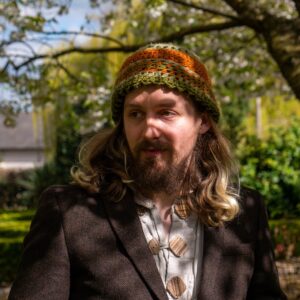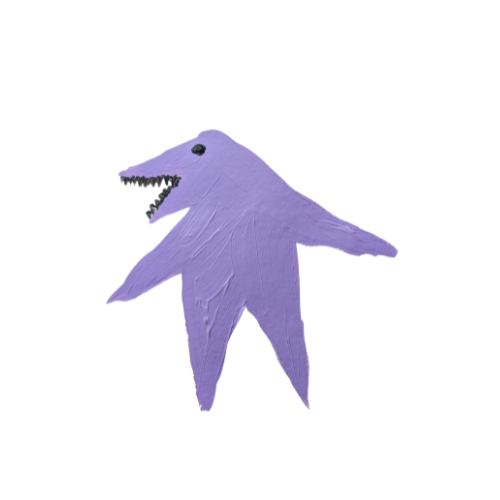
In January 2023 I started a conversations project during my residency at Applecart Arts. I sit down and have a conversation of approximately one hour with someone I am interested to have a conversation with. Whilst there might be particular things I am interested in, I don’t have questions planned in advance and what happens is organic. Whilst we talk, I paint. What I share here is the painted/drawn outcome of the conversation. Afterwards, I write up my reflections which come from the conversation. Then, they go into my gallery of conversations, which you have found yourself in here…
When we spoke, Clement Mawby was currently nearing the end of completing a PhD in quantum mechanics – particularly focusing on connecting physics and philosophy. He lives locally to Applecart. He was the first person to get in contact with me after seeing a sign I’d painted and put up in the cafe, inviting people to have a chat with me. I was so pleased to receive his email.
As I walked to meet Clem, I finished listening to a podcast about awe and links to the polyvagal theory. The guest on the show, Dachner Keltner, was describing how he has categorised eight different “wonders of life” which activate awe in humans; moral beauty, collective effervescence, nature, music, visual design, spiritual and religious, stories of life and death and epiphanies. Basically, the idea is that awe activates the part of the nervous system which helps us in connection and regulation – the ventral vagal. The podcast host and guest talked through different ways we can encounter awe in our lives and how it could benefit our lives, as more connected individuals.
So, with all of this on my mind, I went into the conversation with Clem and learnt that he is a scientist. I told him about the only relevant information I have about physics; 1) that my partner, Joel, studied it and I remember he got 93% on his quantum physics exam at uni, and 2) a recent conversation between Joel and my colleague and friend Madelanne, who had some questions about quantum physics for her book which she asked him about. Other than that I have little to no concept about what it is or what it means. Physics was one of my worst subjects at school.
Clem and I talked about how we would like our contributions to be, to the world. I currently have a question of how to enable the type of creativity I want and have enough security (in terms of things like bills, home, food) so that I don’t have to spend all my time thinking about that and the art becomes a desperate way to try and make ends meet. It feels weird writing that, I’ve never described it quite that honestly before, probably because it makes me aware of the privilege I have to even say it. He recognised some of this in his own quandaries and thinking, particularly in terms of academia.
He talked about how so much of his work is focused on tiny tiny things and how that can seem so far removed from the burning issues which are going on around us. At the same time, Clem said he felt that the tiny parts that he is studying and thinking about in his studies of quantum physics connect to everything that exist in our world. I found this fascinating, how we can be studying everything all at once and simultaneously feel disconnected from what is important. In his work, he would like to make these kinds of concepts more accessible to more people.
He also told me about something called Indra’s net. He described it to me as a Vedic metaphor, about an infinite net, which has a droplet of water or jewel at each vertex, so in each drop you can see every other drop on this infinite net. The idea is that it shows the interconnectedness of absolutely everything. I can’t remember if Clem described it as a spiders web, but that is definitely what I pictured when he described it. A little after this, he looked upwards and pointed out a huge spider web on the ceiling. I have been in there many many times over the past months and hadn’t looked up there before. I liked it.
We also talked about the importance of community and how that can feel difficult in London when we might not find it easy to put down roots. In his life, this can be because of the fragility of academic positions. We also talked about an idea from the podcast on awe, which I probably explained badly but I can try and improve on now. The idea being that in our increasingly-individualised Western way of thinking, moments of awe and wonder can help us connect outside of ourselves and the boundaries become fuzzier of what is “me” and what is everything else. In this way, looking at a beautiful cloud or watching a cat or listening to a piece of music can help us connect to others and even community, if we’re up for thinking of community differently. Clem reminded me of this again when he described not feeling very part of our community in some ways, but in other ways he does through the trees and the crows. I particularly loved the crow reference as I regularly feed the crows on Wanstead flats and I believe they have started to recognise me.
I really enjoyed talking with Clem. I don’t know if I’ve ever met a complete stranger before (bar a couple of emails) and had such a wide-ranging conversation which felt comfortable. I felt a bit like I had the bouncing brain mode which I described in my conversation with Ben Murphie – my favourite improvising mind – but quite a relaxed, slow bounce.
A quote about Indra’s net:
“There hang the jewels, glittering “like” stars in the first magnitude, a wonderful sight to behold. If we now arbitrarily select one of these jewels for inspection and look closely at it, we will discover that in its polished surface there are reflected all the other jewels in the net, infinite in number. Not only that, but each of the jewels reflected in this one jewel is also reflecting all the other jewels, so that there is an infinite reflecting process occurring.”
(Francis H. Cook)

